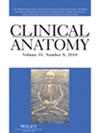Transgenic Models to Study Angiogenesis and Lymphangiogenesis: An Historical Note.
IF 2.3
4区 医学
Q1 ANATOMY & MORPHOLOGY
引用次数: 0
Abstract
The knockout mouse has been a valuable tool for geneticists to discern the role of a gene in embryonic development and in normal physiological homeostasis. The development of transgenic technologies in mice has allowed the study of the consequences of genetic alterations on angiogenesis and lymphangiogenesis. This historical review article summarizes the first literature evidence concerning the use of transgenic models to study the most important factors involved in the regulation of angiogenesis and lymphangiogenesis.
研究血管生成和淋巴管生成的转基因模型:一个历史注释。
基因敲除小鼠已成为遗传学家辨别基因在胚胎发育和正常生理稳态中的作用的宝贵工具。转基因技术在小鼠中的发展使得研究基因改变对血管生成和淋巴管生成的影响成为可能。本文综述了利用转基因模型研究血管生成和淋巴管生成调控中最重要因素的文献证据。
本文章由计算机程序翻译,如有差异,请以英文原文为准。
求助全文
约1分钟内获得全文
求助全文
来源期刊

Clinical Anatomy
医学-解剖学与形态学
CiteScore
5.50
自引率
12.50%
发文量
154
审稿时长
3 months
期刊介绍:
Clinical Anatomy is the Official Journal of the American Association of Clinical Anatomists and the British Association of Clinical Anatomists. The goal of Clinical Anatomy is to provide a medium for the exchange of current information between anatomists and clinicians. This journal embraces anatomy in all its aspects as applied to medical practice. Furthermore, the journal assists physicians and other health care providers in keeping abreast of new methodologies for patient management and informs educators of new developments in clinical anatomy and teaching techniques. Clinical Anatomy publishes original and review articles of scientific, clinical, and educational interest. Papers covering the application of anatomic principles to the solution of clinical problems and/or the application of clinical observations to expand anatomic knowledge are welcomed.
 求助内容:
求助内容: 应助结果提醒方式:
应助结果提醒方式:


